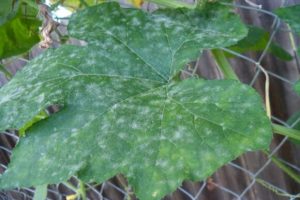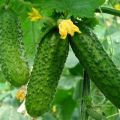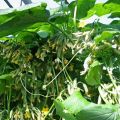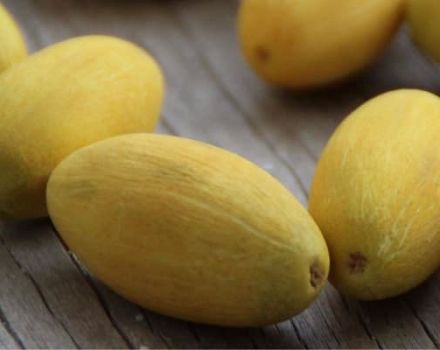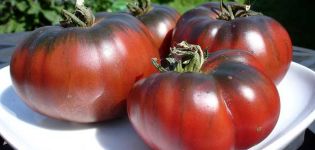The best varieties of cucumbers for the northwest: Altai, Miranda, Cascade, Restina and Altai early
An example of the successful work of breeders is a whole series of cucumber varieties adapted to the difficult conditions of the northern regions. The cucumber Miranda F1, traditionally loved by Siberians, is an example of a culture with increased cold resistance. A cucumber can even grow in unprotected soil. There are many such wonderful varieties. It is impossible to tell about everyone. But we bring a description of some to your attention.
New generation hybrids
It is the hybrid varieties that can be safely planted in low temperature conditions and successfully grown indoors. Already at the f1 genetic level, cucumber has resistance to many diseases and unstable natural factors.
Hybrids, as a rule, have earlier ripening periods and high productivity, the qualities are most relevant in the conditions of a short summer in the west and east of Siberia. In addition, when growing hybrids, you do not have to worry about attracting insects to pollinate the ovaries. Most hybrids have parthenocapies and do not require pollination to form fruit. The best varieties for any type of greenhouse are hybrids.
Unlike varietal plants, in hybrid plants, important economic and commercial characteristics are most strongly manifested: yield, uniformity of varietal traits in all plants, short growing periods. Particularly relevant are resistance to changes in humidity, temperatures, resistance to pathogens of viral and fungal diseases. Therefore, hybrids are ideal for growing in greenhouses.
Miranda F1
The universal early ripening hybrid is cold-resistant and resistant to the main diseases of cucumbers. Can be cultivated in the open air and in greenhouses. No pollination required. The plant is tall, well leafy.
Zelentsy 11-12 cm long, weighing up to 120 g. The yield is good. Up to 6.5 kg of cucumbers per 1 sq. m. Fruits are oblong green, with light specks and white stripes up to the middle of the fruit, with white thorns. Miranda cucumbers are delicious, juicy. Suitable for pickling and pickling.
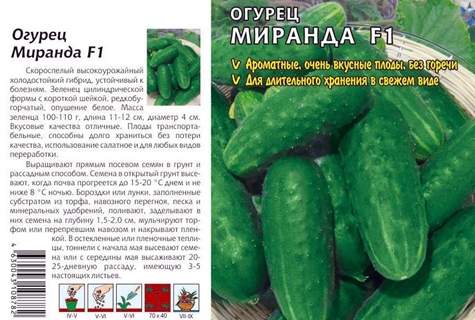
Agricultural technology does not differ from the process of growing most varieties. When the soil warms up to 15 degrees, the seedlings are planted in a permanent place. Most often this is the last decade of May. Plant no more than 3-4 plants per 1 sq. m. Mandatory garter or fastening to the trellis.
Siberian bouquet F1
Early maturing, high-yielding hybrid, does not require pollination and is adapted to the low temperatures of Siberia. Differs in a friendly return of fruits. Can be grown in all types of greenhouses and outdoors, resistant to common diseases.The plant is medium-growing with unusual ovaries of 3-4 cucumbers that look like a bouquet.
Cucumbers up to 10 cm long, elongated, and weighing up to 45-50 g. The hybrid has excellent commercial performance. Its most significant characteristic is its ability to yield up to 30 kg per sq. m. Fruits are aligned in size and shape, have dense flesh, small-seeded, do not taste bitter, ideal for salting.
Cucumber Siberian bouquet f1 is quite picky about care. To obtain the maximum yield, it is necessary to observe the regimes of watering and fertilizing, to remove ripe greens in a timely manner.
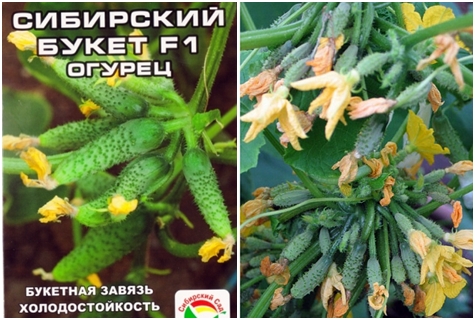
Restina F1
Many seed farms and agricultural firms are developing varieties and hybrids for areas with adverse weather. As a result of the work of breeders of the agricultural firm "Biotekhnika", a super early, high-yielding, bee-pollinated hybrid of Restin f1 appeared on the seed market.
The plant has genetic resistance to the main fungal, viral and bacterial diseases of cucumbers. It takes only 39-40 days from germination to collection. A plant with bouquet ovaries, so it looks unusual. Cucumbers are collected in bunches of 3-5 pieces. They can be grown not only in a greenhouse or garden plot.
The variety is planted in boxes or pots on balconies and loggias. The plant looks very impressive. Zelentsy are small, gherkin type, 5-6 cm long. The surface of the cucumbers is small-tuberous, green with light stripes. The pulp is dense, crispy, suitable for canning, summer and winter salads.
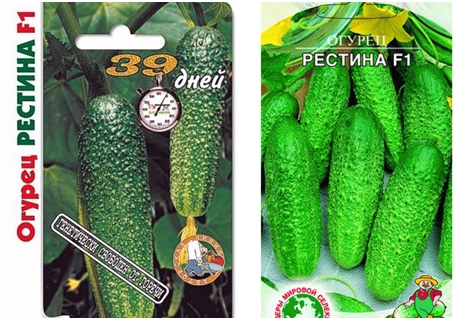
The plant is thermophilic; for areas with a cold climate, a seedling growing method is recommended. The culture is planted in a permanent place when the danger of frost has passed.
Important! When growing bee-pollinated varieties and hybrids with a female type of flower, it is required to plant up to 10-15% of plants of pollinating varieties that form male flowers. They are planted in each row every 7-8 plants of the main variety.
Cucumber varieties pollinated by bees
Cucumber is a thermophilic crop that implies greenhouse cultivation. But plants pollinated by bees do better outdoors. There are many suitable vegetable crops for the traditional horticulturist.
Almost any variety of cucumbers has its own characteristics, but most are cold-resistant and early maturity.
Bee-pollinated varieties have some important differences. Fruits, due to the formation of seeds, accumulate more biologically active substances and vitamins. They are healthier and often have a distinct flavor and aroma characteristic of a vegetable. Zelentsa of these varieties are most suitable for salting. All varieties are adapted for the north and have been tested over the long years of their existence. One of the best for pickling is the Cascade variety, which has already become a classic in vegetable growing.
Cascade
The variety is old, created and registered by Far Eastern breeders back in 1982. It belongs to the category of early maturing with a growth period of up to 45 days. Cucumber bush with female flowers, bee-pollinated, intended for cultivation in protected and open ground. It is resistant to powdery mildew. Fruits are even, 13-15 cm long, weighing 90-120 g, with a green skin. Cucumbers Cascade are famous for their good taste characteristics without bitterness, dense and crunchy. They are considered the best for salting.
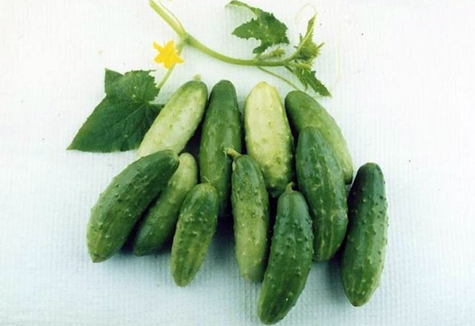
The variety has earned only positive reviews for its consumer qualities. Productivity up to 8 kg per bush per season. The variety is quite thermophilic, prefers areas with fertile soils, well warmed up and protected from the wind. It can be grown by seedlings or by sowing seeds immediately to a permanent place. Seeds germinate at 13-15 degrees. Plants are planted in a greenhouse in early May, and 25 day old seedlings in mid-May.
Planting density up to 4 plants per sq. meter.The most suitable temperature is 25-30 degrees. Care comes down to watering, weeding, timely feeding.
Altai early
The high-yielding variety was created back in 1958, but is still popular today, intended for outdoor cultivation in unprotected soil. The variety is resistant to fungal diseases. The plant is cold-resistant, well adapted to growing in the northern regions, tolerates short-term drops in temperature.
Cucumber Altai early bee-pollinated variety, early ripening, with a growing season of 37-39 days. The plant is highly leafy, with shortened lashes. Fruits are small, about 10 cm long and weighing up to 80 g. The surface of the cucumber is with small tubercles and white thorns. Up to 6 kg of fruits are harvested from a square meter, which are eaten fresh.
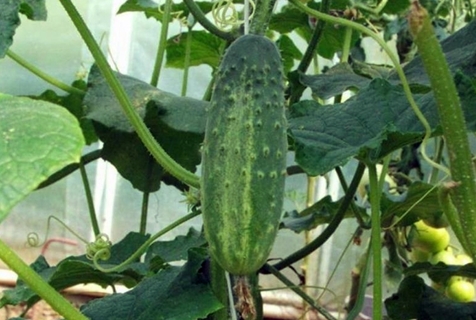
Altai
Another bee-pollinated variety of Altai cucumbers can be cultivated in the open air or in a greenhouse. The plant has an average cold resistance and resistance to some types of cucumber diseases. Its advantage is its early maturity. Subject to the agrotechnical rules, the first crop begins to be harvested in early July. The fruits of the Altai cucumber are large enough, oval in shape, with a tuberous surface.
The weight of the greenery varies in a small range from 90 to 118 g and a length of 9-13 cm. Small-seeded cucumbers of the Altai variety, salted.
Seed manufacturers in the recommendations suggest sowing seeds directly into the ground in early May, when grown under film shelters. If the seedling method is chosen, then the dates are postponed to mid-May. Seedlings 20-25 days old should have 3-5 leaves. Planting scheme 70 x 40.
Cucumber is heat demanding. The roots of the plant are located at a shallow depth of 20-30 cm. On soils with a temperature of 17-19 degrees during the day and 12-14 at night, plants of early maturing varieties begin to bear fruit in 40-45 days, mid-ripening in 45-55 days. The plant is especially demanding for heat during flowering and fruiting periods.
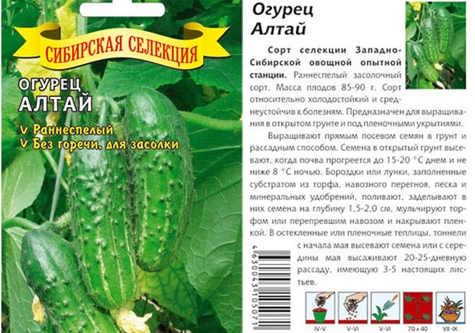
Growing cucumber culture
Cucumber grows well in warm, light, humus-rich fertile soils. Poorly tolerates acidic and saline soil.
- Cucumber seeds germinate at a temperature of 13-15 degrees. The optimum temperature for fast germination of seeds is 25-30 degrees.
- The culture is especially responsive to soil moisture and relative air humidity. The root system of the plant is located in the upper, rapidly drying soil layers. Large leaves require a lot of moisture and nutrients.
- Cucumbers are light-loving short-day crops. A short day is especially favorable during the growing season.
- Seedlings are planted when the soil warms up to 15 degrees, when the danger of recurrent frosts has passed. Plants in greenhouses are tied or attached to trellises.
- The plant is formed by pinching at the height of the greenhouse. Pinching is not needed for early ripening varieties, since female and male flowers form in them simultaneously, on the main stem and lateral shoots.
- Before the start of fruiting, the temperature should be 22-24 degrees during the day and 17-18 degrees at night.
- The moisture content of the soil is maintained depending on the illumination at the level of 75% to 90%. On especially hot days, refreshing watering is carried out.
- After watering, the soil is loosened, thereby providing air access to the root system. Remove leaves from the bottom of the stem. Timely removing ripe greens.
These rules are quite traditional and are true for varieties and hybrids with different ripening times.
